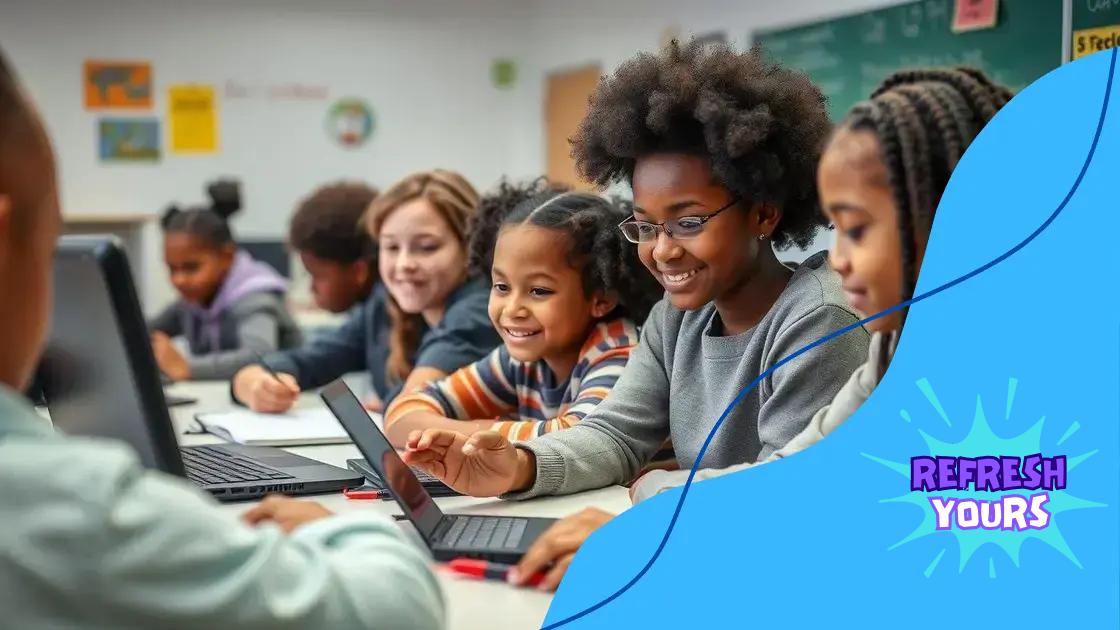The shift toward competency-based education in K-12 schools

The shift toward competency-based education in K-12 schools emphasizes personalized learning, technology integration, and social-emotional growth, equipping students with skills relevant to both academics and real-world situations.
The shift toward competency-based education in K-12 schools is gaining momentum, reshaping traditional learning methods. Are these changes the answer to optimizing student success? Let’s explore this growing trend.
Understanding competency-based education
Understanding competency-based education involves recognizing its core principles and how it differs from traditional education. This approach focuses on what students learn, rather than how much time they spend on each subject. The goal is to ensure that all students acquire the necessary skills and knowledge required to succeed.
In a competency-based model, students progress at their own pace. This means some might finish faster than others, allowing for a tailored learning experience. Educators work closely with students to set individual learning goals.
Key Aspects of Competency-Based Education
There are several essential components that define competency-based education:
- Personalized Learning: Each student’s learning journey is unique.
- Mastery Focus: Students advance only when they demonstrate mastery of the material.
- Real-World Applications: Emphasizes skills that are relevant to real-life situations.
This educational model encourages students to take ownership of their learning. They become active participants, ensuring that they’re engaged with the material. Educators support this process by providing resources and guidance tailored to each learner’s needs.
Incorporating technology can greatly enhance the competency-based approach. Online platforms allow students to access a wealth of information and learning tools. These resources facilitate deeper understanding and foster independent learning habits.
The Role of Assessment
Assessment in a competency-based system shifts to measuring performance against clear criteria. Traditional testing methods may not apply. Instead, assessments are often ongoing, allowing teachers to track progress and identify areas for improvement in real time.
Understanding competency-based education empowers both parents and educators to better support students. This method fosters a learning environment where every child can thrive, making education more accessible and relevant to their needs.
Key benefits for students and teachers
Understanding the key benefits for students and teachers in a competency-based education system highlights how this approach transforms the learning experience. Both students and teachers find unique advantages that enhance educational outcomes.
One of the most significant benefits is personalized learning. Students can work at their own pace, allowing those who grasp concepts quickly to advance faster. This flexibility ensures that each learner receives the attention they need.
Enhanced Engagement
Competency-based education fosters greater engagement among students. When learners are active participants in their own educational journey, they tend to be more motivated. This creates an environment where curiosity thrives, leading to deeper understanding and retention of material.
- Increased Motivation: Students take ownership of their learning.
- Active Participation: Emphasizes hands-on experiences.
- Collaboration: Encourages teamwork among peers.
For teachers, this approach allows for more meaningful interactions with students. Instructors can tailor their teaching methods to meet individual needs, focusing on areas where students struggle. This personalized attention leads to higher rates of achievement.
Real-World Application
Competency-based education emphasizes real-world applications of knowledge. Students learn skills that are directly relevant to their future careers. This ensures that they are not only prepared academically, but also equipped for the workforce.
Teachers benefit from being able to align curriculum with industry standards. This connection helps students see the value in their education and how it applies beyond the classroom. Making learning relevant enhances overall student success.
Challenges of implementing new systems

Implementing new systems in education, particularly with competency-based education, comes with its set of challenges. Understanding these obstacles is essential for a successful transition.
One major challenge is the shift in teaching practices. Teachers accustomed to traditional methods may struggle to adapt to a system where students dictate their own pace. This requires ongoing training and support.
Resistance to Change
Many educators and administrators may resist changing established practices. This reluctance can stem from comfort with the status quo or fear of the unknown. Addressing these concerns is vital.
- Training Requirements: Teachers need comprehensive training to effectively manage competency-based systems.
- Parent Involvement: Educating parents about the benefits of the new approach can reduce resistance.
- Cultural Shifts: Moving from a fixed mindset to a growth mindset takes time.
Additionally, resource allocation plays a significant role in the implementation process. Adequate funding is necessary to provide the required tools, technology, and training for teachers.
Measuring Success
Another challenge lies in how success is measured within a competency-based framework. Traditional assessments may not apply effectively, leading to the need for new evaluation methods. Developing accurate assessments that reflect student understanding and progress can be complex.
Furthermore, there may be variability in how quickly different students adapt to this system. Individual student needs must be accounted for, requiring educators to be flexible and patient.
Effective strategies for transition
Implementing effective strategies for transition to a competency-based education system is crucial for success. Schools can adopt several approaches to make this change smoother for students, teachers, and administrators alike.
One key strategy is providing comprehensive professional development for teachers. This training helps educators understand the new system and equips them with the tools they need. Establishing a support network within the school can also improve teacher confidence and collaboration.
Engaging Stakeholders
Engaging all stakeholders, including parents, students, and community members, is essential. Informing them about the benefits of competency-based education creates a supportive environment. Hosting workshops and meetings, where concerns can be addressed, encourages community involvement.
- Open Communication: Maintain ongoing dialogue with all stakeholders.
- Feedback Mechanisms: Implement ways to gather input from teachers and parents.
- Celebrating Success: Acknowledge and showcase early wins to build enthusiasm.
Creating a phased implementation plan can also ease the transition. This method allows schools to pilot the new system in certain grades or subjects before broader adoption. This way, educators can refine the approach based on real experiences.
Utilizing Technology
Technology can play a significant role in supporting the transition to competency-based education. Educators can use various digital tools to track student progress and provide personalized learning experiences. Online platforms facilitate communication between teachers and students, creating a more connected learning environment.
Additionally, leveraging existing resources and partnerships can help schools manage costs. Collaborating with educational technology providers can give schools access to innovative solutions tailored to their needs. As schools design their competency-based systems, these strategies can significantly enhance the overall effectiveness of the transition.
Future trends in K-12 education
Exploring future trends in K-12 education reveals exciting possibilities. With the rise of technology and new educational philosophies, the classroom is undergoing significant transformations.
One major trend is the increased use of personalized learning. As schools adopt competency-based models, students will experience instruction tailored to their unique needs. This individualized approach allows students to progress at their own pace and focus on areas needing improvement.
The Role of Technology
Advancements in technology will continue to play a key role in education. Online resources, educational apps, and virtual learning environments are becoming commonplace. These tools enhance the learning experience and allow for greater student engagement.
- Interactive Learning: Students can interact with educational content through simulations and games.
- Data-Driven Decisions: Educators will use data to track student performance and adjust instruction accordingly.
- Remote Learning: Flexibility in learning environments will become essential, accommodating various student needs.
Another trend is the emphasis on social-emotional learning (SEL). Schools are recognizing the importance of supporting students’ emotional and social well-being. Integrating SEL into the curriculum prepares students for life beyond academics.
Collaborative Learning Environments
Future K-12 education will likely see a rise in collaborative learning environments. Students will work together on projects that foster teamwork and communication skills. This approach encourages peer learning and develops critical thinking.
Additionally, partnerships between schools and community organizations will expand. These collaborations can provide students with real-world experiences and connections to local resources. As education evolves, these trends will shape a more dynamic and supportive learning landscape.
FAQ – Frequently Asked Questions about Competency-Based Education
What is competency-based education?
Competency-based education focuses on students mastering specific skills and knowledge at their own pace rather than being bound by traditional time limits.
How does technology enhance competency-based learning?
Technology provides tools and platforms that allow for personalized learning experiences, enabling students to access resources and track their progress effectively.
What are the benefits of personalized learning?
Personalized learning tailors education to individual student needs, improving engagement and catering to different learning paces and styles.
How can schools implement social-emotional learning?
Schools can integrate social-emotional learning by providing programs that focus on emotional intelligence, empathy, and relationship skills, fostering a supportive learning environment.





